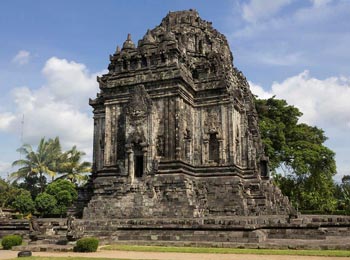- Others
Kalasan Temple / Candi Kalibening
- Kalibening,Yogyakarta
- View on map
- Tell us about this temple
Overview
Kalasan is also called Candi Kalibening. It is an 8th-century Buddhist temple in Java, Indonesia. It is situated about 13 km to the east of Yogyakarta on the way to Prambanan temple, on the south side of the main road 'Jalan Solo' between Yogyakarta and Surakarta.
About The Temple
The temple remains on 14.20 meters sub-storm cellar. The temple plan is cross-formed, and planned as a twelve-cornered polygon. Each of four cardinal focuses has stairs and doors decorated with Kala-Makara and rooms measuring 3,5 square meters. Not a single statue is in sight in the littler rooms confronting north, west, and south; however the lotus platforms recommend that the rooms once contains statues of Bodhisattvas. The temple is luxuriously designed with buddhist figures, for example, the Bodhisattva and gana. The Kala Face over the southern entryway has been captured and utilized by various outside scholastics in their books to give a thought of the creativity in stone by Central Javanese specialists of centuries prior. Specialties where the statues would have been set are found inside and outside the temple. The specialties enhanced an external divider unpredictably cut with Kala, divine beings and divinities in scenes delineating the svargaloka, heavenly royal residence of the divine beings, apsaras, and gandharvas.
The top of the temple is planned in three segments. The lower ones are as yet as per the polygonal state of the body and contain little specialties with statues of boddhisatvas situated on lotus. Each of these specialties is delegated with stupas. The center part of the rooftop is in octagonal (eight sided) shape. Each of these eight sides embellished with specialties contains statue of a Dhyani Buddha flanked by two standing boddhisatvas. The top part of the rooftop is practically roundabout and further more have 8 specialties delegated with single expansive dagoba. The octagonal part of the structure has prompted to hypothesis of non-buddhist components in the temple, like a few translations of the early Borobudur structure.
The temple is confronting east, with eastern room likewise filled in as access to fundamental focal room. In the bigger principle room there is lotus platform and position of royalty cut with makara, lion, and elephant figure, like the Buddha Vairocana royal position establishes in Mendut temple. As per the Kalasan engraving, the temple once houses the extensive (presumably achieving 4 meters tall) statue of the Boddhisattvadevi Tara. By the plan of the royal position, most presumably the statue of the goddess was in situated position and produced using bronze. Presently the statue is missing, most likely an indistinguishable destiny from bronze Buddha statue in Sewu temple, being plundered for scrap metal over hundreds of years.
On the external mass of the temple found the hints of mortar called vajralepa (lit: precious stone mortar). A similar substance additionally establishes in close-by Sari temple. The white-yellowish mortar was connected to secure the temple divider, yet now the mortar has worn off.
The temple is situated on archeologically rich Prambanan plain. Only a couple of hundred meters north east from Kalasan temple is found Sari temple. Candi Sari most presumably was the religious community said in Kalasan engraving. Promote east lies the Prambanan complex, Sewu temple, and Plaosan temple.
Legend And Stories
History
As indicated by the Kalasan engraving dated 778 AD, written in Sanskrit utilizing Pranagari script, the temple was raised by the will of Guru Sang Raja Sailendravamçatilaka (the Jewel of Sailendra family) who prevailing with regards to inducing Maharaja Tejapurnapana Panangkaran (in another part of the engraving likewise called Kariyana Panangkaran) to develop Tarabhavanam, a blessed working for the goddess (boddhisattvadevi) Tara. Also, a vihara (religious community) was worked for buddhist ministers from the Sailendra family's domain. Panangkaran granted the Kalaca town to sangha (buddhist ascetic group). As indicated by the date of this engraving, Kalasan temple is the most seasoned of the temples worked in the Prambanan Plain. Regardless of being redesigned and somewhat revamped amid the Dutch pioneer period, the temple right now is in poor condition. Contrasted with different temples adjacent, for example, Prambanan, Sewu, and Sambisari the temple is not all around kept up.
How To Reach Indonesia
Indonesia’s main international airport is Soekarno-Hatta International Airport, Jakarta. Semarang, Jakarta, Bali, Pontianak, Tanjung Pinang, Kupang and Balikpapan are seaports for entry to the country. A number of cruise liners on the South-East Asia circuit make at least one of these a port of call.
Temple Address
Kalasan Temple / Candi Kalibening,
Kalibening, Kalasan District,
Yogyakarta, Indonesia.
Significance
Devotees visit this temple to seek fulfillment of the following:-
- Peace of Mind
Shlokas
Balam Balavatam Caham Kamaragavivarjitam Dharmaviruddho Bhutesu Kamo'smi Bharatarsabha
Meaning -According to this sloka, God is the isolated and aloof strength of the controlling and virtuous craving in men.
Ye Caiva Sattvika Bhava Rajasastamasasca Ye Matta Everti Tanviddhi Na Tvaham Tesu Temayi
Meaning -According to this sloka, though the only source of satva, rajas and tamas (good, obsessive and dark) elements is God, they are not present within the God or the deity.
Tribhirgunamayairbhavairebhih Sarvamidam Jagat Mohitam Nabhijanati Mamebhyah Paramavyayam
Meaning -According to this sloka, the entire world doesn't recognize the eternal God beyond them, because they are consumed by the elements of satva, rajas and tamas (good, obssessive and dark).
Daivi Hyesa Gunamayi Mama Maya Duratyaya Mameva Ye Prapadyante Mayametam Taranti Te
Meaning -According to this sloka, the heavenly maya of God is very complicated, but those who worship God will be able to overcome it.
Timings
The temple is open from 6AM to 9PM.
